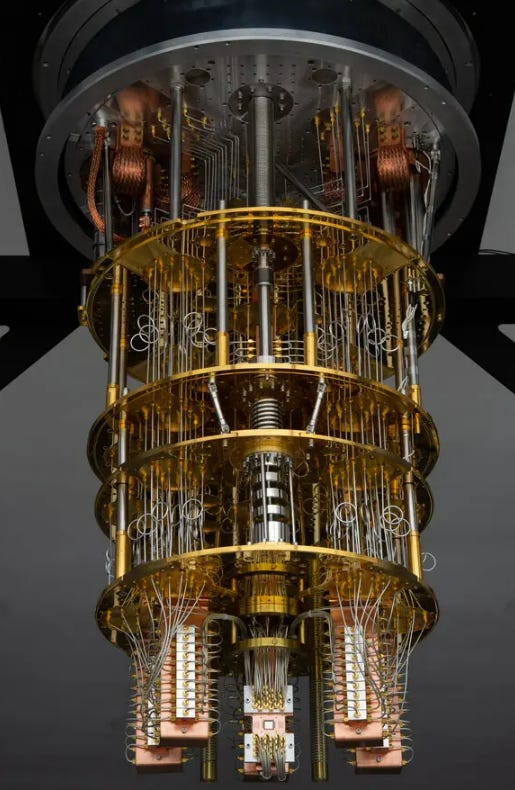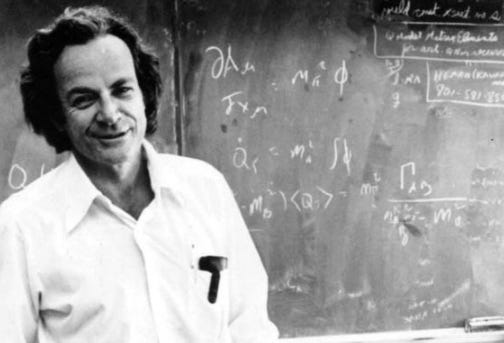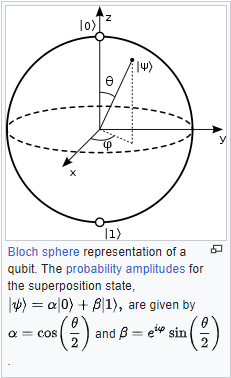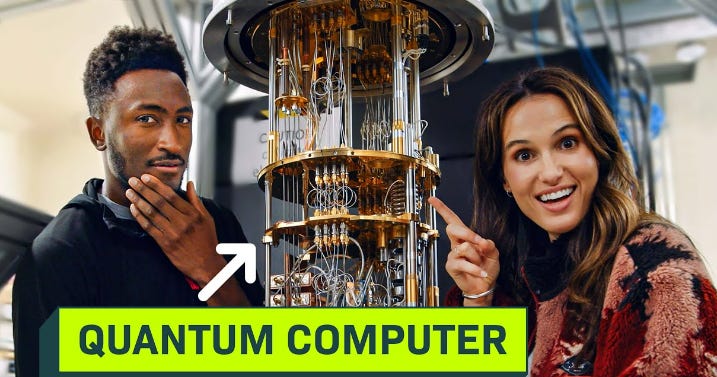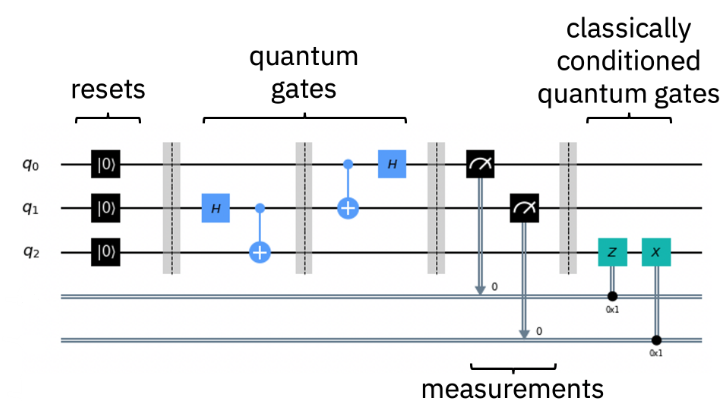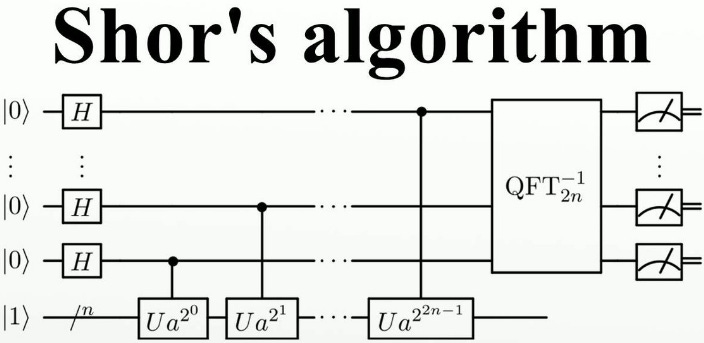Hi Gang,
Imagine a larger cylinder refrigerator, sealed from the outside world, and held together by mechanical rivets. The temperature in this refrigerator is the closest thing to absolute zero that has been made with human technology. Suspended within the environment such extreme temperatures would create, isolated from everything else in existence, is located a working quantum computer. A quantum computer, some would say, evokes the possibility of a future for the human species, similarly to those we see imagined in movies such as Star Wars. This technology has the potential to change our lives into an unimaginable existence with parabolic advancements in science, medicine, engineering, and technology. People often confuse quantum computers with supercomputers, which are commercialized even today. Quantum computers are an entirely different technology that combines two fascinating areas: quantum physics and computer science. Quantum computing is a very complicated and difficult subject to grasp but to understand the basics, let's dive into the fundamental physics that drives this cutting-edge technology.
At the heart of quantum computing is the peculiar world of quantum mechanics. This world is small that it fits into another dimension. This dimension is so alien to our world that we cannot intuitively understand it. We tend to think that reality seems to behave in predictable ways. But in the 1980s, Richard Feynman, a renowned physicist,
left an indelible mark on the field of quantum mechanics and theoretical physics by dreaming up the first quantum computer and therefore bridging the gap between the stuff that lives in quantum world and computer science in our world. But what made these worlds so drastically different if it seems that one cannot exist without the other? Amplitudes. Think of amplitudes as the "voting power" of different paths a particle can take. Just like voters decide the outcome of an election, amplitudes determine the likelihood of a particle being in a particular state. The higher the amplitude, the greater the probability of the particle being found in that state. One fascinating aspect of amplitudes is their ability to interfere with each other. Just like ripples on the surface of water can combine to create patterns, amplitudes can add up or cancel out when particles take different paths. This interference leads to interesting phenomena such as wave-like behavior and the famous double-slit experiment, which I’ll write about later on in this article. In quantum mechanics, amplitudes are typically represented by complex numbers, which consist of both real and imaginary parts. These complex numbers allow for a rich mathematical description of particle behavior, incorporating both magnitude and phase information. By studying amplitudes and their interactions, physicists gain insights into the fundamental workings of the quantum world. They can make predictions about the probabilities of different outcomes in experiments and explain the behavior of particles at the microscopic level. Tiny existences that we call subatomic particles.
This concept is where quantum computing comes from. Subatomic particles are the tiny building blocks of matter that make up everything around us. These particles include electrons, protons, and neutrons, which form the structure of atoms. However, when we delve into the realm of quantum mechanics, these particles reveal a dual nature: they can exhibit both particle-like and wave-like behaviors. One fascinating concept in quantum mechanics is the wave of probability, often represented by a wave function. It describes the likelihood of finding a particle in different locations or states. Instead of pinpointing the exact position of a particle, the wave function gives us a range of possible positions where the particle is likely to be found.
As promised and to visualize this, let's consider the famous double-slit experiment. Imagine shining a beam of light or firing particles, like electrons, at a barrier with two small slits. If particles were strictly behaving like classical particles, we would expect them to pass through one slit or the other, forming two distinct lines on a screen behind the barrier. However, something peculiar happens. When particles are fired individually, they create an interference pattern on the screen. This pattern resembles the ripples formed by dropping two stones in a pond, where the waves intersect and create areas of reinforcement or cancellation. Similarly, the particles' wave functions interfere with each other, producing regions of high and low probabilities for particle detection. This phenomenon demonstrates the wave-like nature of particles. Each particle's wave function spreads out and passes through both slits simultaneously, creating an interference pattern as the waves interact. It's as if the particle explores all possible paths and interferes with itself, resulting in the observed pattern on the screen. Yet, when we try to observe or measure the particle's position, the wave function collapses into a specific location. It's like the ripples on the pond collapse into a single point when we try to catch them. This collapse gives us a definite outcome and reveals the particle-like behavior of subatomic entities.
Click here to watch The Double Slit Experiment FULLY EXPLAINED
How do quantum computers use amplitudes to store and manipulate information quantumly? Well, the answer isn’t so simple. In fact, nothing about quantum computing is simple to explain and or understand. I will do my best to embark on a journey into the mind-bending world of quantum computing, where amplitudes hold the key to storing and magically manipulating information on a quantum scale. We will start with quantum bit or more widely used, a qubit.
Qubit is the fundamental building block of quantum computing. It is the quantum counterpart of the classical bit used in traditional computing. While a classical bit can exist in one of two states, either 0 or 1, a qubit can exist in a superposition of both states simultaneously. The superposition property of a qubit allows it to be in multiple states at once, representing a combination of 0 and 1. This unique characteristic enables quantum computers to perform multiple calculations in parallel, vastly increasing their computational power compared to classical computers. Moreover, qubits have another intriguing property called entanglement. When qubits become entangled, the states of multiple qubits become intertwined, and manipulating one qubit instantly affects the others, regardless of the distance between them.
This phenomenon is the key concept in understating why quantum computing can be powerful. Quantum computing opens a realm of mind-boggling possibilities and has the potential to revolutionize several fields. This very real breakthrough has already captivated by three groundbreaking applications that have set the world abuzz:
1. Breakthroughs in Drug Discovery: Imagine a future where quantum computers help us discover life-saving medicines faster than ever before. With their immense computational power, quantum computers can simulate the behavior of complex molecules and understand how they interact with drugs. This could speed up the process of drug discovery by predicting the effectiveness and potential side effects of new medications, leading to more precise and tailored treatments for various diseases.
2. Supercharged Optimization: Optimization problems are everywhere, from logistics and supply chain management to financial portfolio optimization. Quantum computing offers a quantum leap in solving these challenges. By harnessing the power of qubits, quantum computers can explore countless possibilities simultaneously, finding the best solutions in a fraction of the time it would take classical computers. This could revolutionize industries by optimizing complex systems, minimizing costs, and improving efficiency on an unprecedented scale.
3. Unbreakable Encryption: In a world where data security is paramount, quantum computers could provide an unprecedented level of cryptographic protection. Quantum cryptography exploits the fundamental principles of quantum mechanics to create unbreakable encryption schemes. By utilizing the unique properties of qubits, quantum communication protocols can ensure secure transmission of information, detecting any attempts at eavesdropping or tampering. This could transform data privacy, making sensitive information virtually impenetrable and revolutionizing the world of cybersecurity.
Click here to watch a cool video collaboration by Cleo Abram and Marques Brownlee
These are just a glimpse into the astonishing possibilities that lie ahead. Quantum computing holds promise for solving complex optimization problems, accelerating scientific discoveries, transforming data security, and potentially unraveling mysteries that are beyond the reach of classical computing. Quantum computing does all of this using the computer science breakthrough of interference. Imagine you're an expert cake decorator preparing to create a masterpiece. You have an array of colorful icing tubes, each representing different possibilities. In quantum computing, these possibilities are like the different paths a particle can take. But here's where it gets interesting: instead of decorating the cake with just one color, you can apply icing from multiple tubes at once, blending them together. Now, think of these icing tubes as waves of probabilities, each carrying a specific pattern. As you combine the different colors, they overlap and interfere with one another, creating a beautiful and unique design. Similarly, in quantum computing, particles can take multiple paths simultaneously and their wave-like properties interfere with each other, creating patterns of constructive and destructive interference. Just as blending icing colors creates a mix of vibrant and muted tones, in quantum computing, constructive interference enhances certain outcomes, while destructive interference suppresses others. By carefully controlling these interferences, quantum computers can exploit the strengths and weaknesses of different possibilities to find the best solution to a problem. It's like having a magical artistic touch, where the combination of icing colors generates a stunning pattern that is greater than the sum of its parts. In quantum computing, harnessing interference allows us to tap into the richness of parallel possibilities and discover powerful solutions that classical computers could only dream of. So, interference in quantum computing is like an artistic symphony of possibilities, where different paths blend and interact, creating an exquisite dance of probabilities that leads us to the most promising solutions. It's the quantum version of mixing icing colors to create a cake that surpasses ordinary creations with its beauty and complexity.
Now imagine you're a detective trying to crack a mind-boggling mystery. You're faced with a wall of locked doors, each hiding a clue that will help you unravel the case. In classical computing, you'd need to check each door individually, one at a time, until you find the right one. It can be a painstaking process, especially if there are numerous doors. But what if you had access to a quantum algorithm, a powerful tool that takes advantage of the quantum world's peculiarities? Picture this: instead of checking the doors one by one, you can explore all the doors simultaneously, like a ghost detective phasing through each door at once. In quantum computing, the magic lies in the interference we mentioned earlier. Just as the icing colors in our previous analogy blended and interfered to create beautiful patterns, the quantum algorithm exploits interference to find the hidden clue efficiently. As you approach the wall of doors, you send out quantum particles that are in a superposition of states, just like the simultaneous presence of all icing colors. These particles probe all the doors simultaneously, exploring every possibility at once. It's as if multiple versions of you are investigating different doors simultaneously, gathering information in parallel. Now comes the key part: interference. The quantum particles, like waves of probabilities, interfere with each other as they explore the doors. Certain paths reinforce each other, amplifying the probability of finding the right clue, while other paths cancel each other out, decreasing the chances of finding irrelevant information. By carefully designing the quantum algorithm and controlling the interference, you can extract the desired clue with a significantly higher probability than classical methods. It's like having an army of detective versions collaborating and sharing information, collectively homing in on the solution much faster. Quantum algorithms harness the quantum world's unique properties, such as superposition and interference, to efficiently solve complex problems that would take classical computers ages to crack. They offer a glimpse into a realm where parallel exploration and probabilistic reasoning work in harmony, unveiling solutions that were previously hidden in the vastness of possibilities. So, a quantum algorithm is like a detective's secret weapon, enabling you to simultaneously explore multiple paths, exploit interference to amplify relevant information, and solve mysteries with unprecedented speed and efficiency. It's the quantum counterpart to cracking cases, where the rules of classical investigation are beautifully twisted, and the quantum detective reigns supreme.
Since the milestone discovery of Shor's algorithm in 1994, quantum computing has witnessed a series of remarkable breakthroughs in the field of quantum algorithms. These groundbreaking advancements have pushed the boundaries of what we thought was computationally possible. Let's explore a few of the major breakthroughs:
1. Shor's Algorithm: Shor's algorithm, introduced by mathematician Peter Shor, is arguably the most famous quantum algorithm to date. It demonstrated that a quantum computer could efficiently factor large numbers, a task considered computationally infeasible for classical computers. Shor's algorithm has significant implications for cryptography, as it threatens the security of widely used encryption schemes based on the difficulty of factoring large numbers. This breakthrough catapulted the field of quantum computing into the spotlight, capturing the imagination of researchers and spurring further exploration.
2. Grover's Algorithm: In 1996, Lov Grover devised an algorithm that provides a quadratic speedup for unstructured search problems. It allows a quantum computer to find a specific item in an unsorted database much faster than classical algorithms. Grover's algorithm has wide-ranging applications, from searching through vast amounts of data to optimizing problem-solving in various domains. While it doesn't pose a threat to current encryption methods like Shor's algorithm, it offers potential improvements in database search and optimization tasks.
3. Quantum Machine Learning: The field of machine learning has also seen breakthroughs in the context of quantum algorithms. Quantum machine learning combines the power of quantum computing with the principles of classical machine learning. Quantum algorithms for tasks such as pattern recognition, clustering, and classification have been developed, showcasing the potential for improved performance and efficiency in certain machine learning tasks.
4. Quantum Simulation: Quantum simulation involves using quantum computers to simulate the behavior of complex quantum systems. Simulating quantum systems is a challenging problem for classical computers due to the exponential growth of computational resources required. Quantum algorithms for simulation hold promise in studying chemical reactions, optimizing materials for various applications, and understanding quantum phenomena that are difficult to explore in the laboratory.
These breakthroughs have propelled quantum computing forward, inspiring researchers to explore the vast landscape of quantum algorithms and their applications. While the field is still in its early stages, these achievements offer glimpses into the transformative power of quantum computing. As researchers continue to push the boundaries, we can anticipate even more astonishing breakthroughs that will shape the future of computation and scientific discovery.
While we marvel at the breakthroughs achieved so far, the most thrilling aspect of quantum computing lies in the vast uncharted territory, brimming with unforeseen applications that will revolutionize our world in ways we can only dream of. Just as early explorers set sail with a sense of wonder and uncertainty, today's quantum pioneers embark on a quest for discovery, guided by the fundamental principles of quantum mechanics. The true beauty lies in the fact that we cannot yet fully fathom the astonishing breakthroughs that await us. It's like gazing at a night sky teeming with constellations, knowing that countless celestial wonders remain hidden from our sight. One potential realm where quantum computing could unleash its transformative power is drug design and personalized medicine.
Click here to watch Quantum Computers Could Change Everything
By harnessing the vast computational capabilities of quantum computers, scientists may unravel the intricate details of molecular interactions and develop groundbreaking drugs tailored to individual patients. This could revolutionize healthcare, offering precise treatments with minimal side effects, while tackling diseases that have long confounded medical experts. Another mysterious frontier lies in the optimization of complex systems, where quantum algorithms could revolutionize logistics, transportation networks, and supply chains. Quantum optimization could help us streamline routes, maximize efficiency, and minimize waste, paving the way for a world where resources are utilized with utmost precision. Picture a world where deliveries arrive promptly, traffic flows seamlessly, and energy consumption is finely optimized, all thanks to the quantum algorithms humming beneath the surface. And let's not forget the mind-bending world of quantum communication, where the intricacies of entanglement hold promise for secure and unbreakable encryption. Imagine a world where our sensitive data and communications are shielded by the laws of quantum physics, rendering them impervious to even the most sophisticated cyber threats. Quantum communication could transform our digital landscape, ensuring privacy and fortifying our digital identities in ways that were previously unimaginable. But here's the real marvel: beyond these glimpses into the future, there are applications that lie far beyond the reach of our current understanding. The realm of the unknown beckons, with puzzles yet to be solved, mysteries yet to be unraveled. It's like venturing into uncharted cosmic territories, where astonishing phenomena await our discovery. So, let us embrace the captivating uncertainty and embark on this quantum odyssey, driven by the insatiable human spirit of exploration. The applications that elude our present knowledge will define our future reality. In this extraordinary quantum landscape, the possibilities are boundless, and the discoveries waiting to be made will reshape our world in ways that both challenge and captivate our wildest imaginations.
As always, thank you for reading.
- J. Gaud
Click here to navigate to an interesting NewScientist article
Bibliography
"Quantum Computing in Drug Discovery: Accelerating Computational Workflows" - Research Article by R. Pollock et al. (2021) - This article explores the potential of quantum computing in accelerating computational workflows for drug discovery. It discusses the application of quantum algorithms and simulation techniques in areas such as molecular modeling, virtual screening, and drug design. [Source: Research Article - Nature Communications]
"Quantum Computing for Pharmaceutical Discovery and Development" - Review Article by M. Reeve et al. (2020) - This review provides an overview of the applications of quantum computing in pharmaceutical discovery and development. It discusses the use of quantum algorithms, such as quantum machine learning and quantum simulation, for tasks such as ligand-based and structure-based drug design, property prediction, and virtual screening. [Source: Review Article - Trends in Biotechnology]
"Quantum Computing in Drug Discovery: Perspectives and Challenges" - Review Article by S. Patel et al. (2020) - This review article examines the perspectives and challenges of integrating quantum computing into the drug discovery process. It discusses the potential benefits of quantum computing in areas such as molecular dynamics simulations, quantum chemistry calculations, and optimization algorithms for drug design. [Source: Review Article - Molecular Informatics]
Quantum Computing: A Gentle Introduction" by Eleanor Rieffel and Wolfgang Polak - This book provides a beginner-friendly introduction to the principles and applications of quantum computing, covering topics such as qubits, quantum algorithms, and quantum error correction.
"Surely You're Joking, Mr. Feynman!" by Richard P. Feynman - This entertaining memoir by Richard Feynman offers insights into his life, work, and contributions to quantum physics. It provides a glimpse into Feynman's fascinating personality and his approach to scientific inquiry.
"Quantum Computing since Democritus" by Scott Aaronson - In this thought-provoking book, Scott Aaronson explores the fundamentals of quantum computing, delving into topics such as quantum algorithms, complexity theory, and the philosophical implications of quantum mechanics.
"The Quantum Universe: Everything That Can Happen Does Happen" by Brian Cox and Jeff Forshaw - Written by renowned physicists Brian Cox and Jeff Forshaw, this book offers a captivating exploration of quantum physics, taking readers on a journey through the fascinating world of subatomic particles and the principles that govern them.
"Quantum Computing for Computer Scientists" by Noson S. Yanofsky and Mirco A. Mannucci - Geared towards computer scientists, this book provides an introduction to quantum computing from a computer science perspective. It covers the basic principles of quantum mechanics and quantum algorithms, offering insights into the computational power of quantum computers.
Wikipedia contributors. (2023, May 17). Qubit. In Wikipedia. Retrieved May 17, 2023, from https://en.wikipedia.org/wiki/Qubit
BBVA OpenMind. (n.d.). Richard Feynman: The Physicist Who Didn't Understand His Own Theories. BBVA OpenMind. Retrieved from https://www.bbvaopenmind.com/en/science/leading-figures/richard-feynman-the-physicist-who-didnt-understand-his-own-theories/
Unknown. (2023, June 14). Quantum Computer [Image]. Retrieved from The New York Times website: https://www.nytimes.com/2023/06/14/science/ibm-quantum-computing.html

